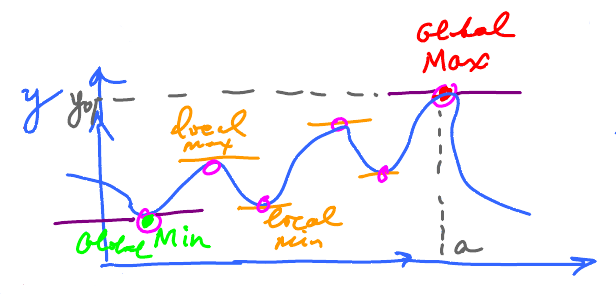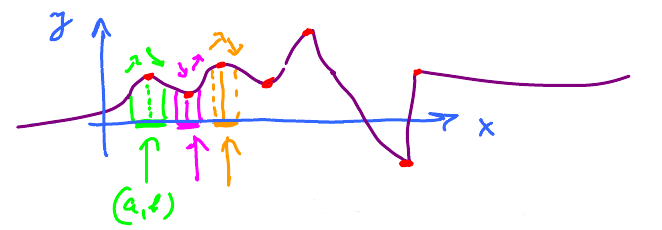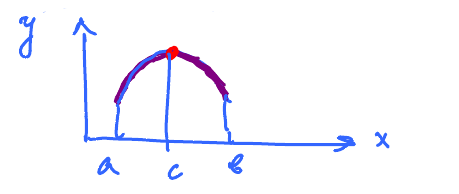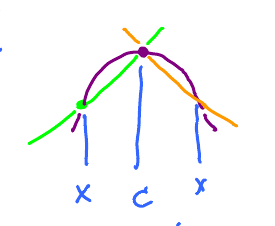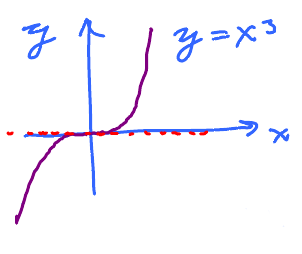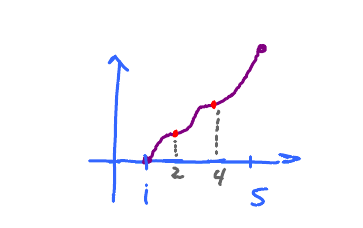This site is being phased out.
Using derivative to find extreme values
We know that it might be possible to find maximum and minimum values of functions, if the functions are continuous.
Now practically, how can we use the derivative, $f^{\prime}$, to find global max/min?
Recall, these special points have horizontal tangents or they have no tangents at all.
So, we need to find all $x$'s such that
- $f^{\prime}(x) = 0$, or
- $f^{\prime}(x)$ does not exist, or
- $x$ is $a$ or $b$ (if the domain is $[a,b]$ etc).
But what exactly does this give us? The derivative $f^{\prime}(c)$ is defined as a limit with $x$ approaching $c$. This is why it reflects only the behavior of $f$ close to $c$:
The idea of getting only the values of $f(x)$ for $x$ close to $c$ is presented more precisely in
- Definition
- A function $f$ has a local minimum point at $x = c$ if
- $f(a) \leq f(x)$ for all $x$ ... (no not all!)
in some interval $(a, b)$ that contains $c$. ("some" = "there is")
Example: Local Max and Min
- Definition
- A function $f$ has a local maximum point at $x = c$ if
- $f(a) \geq f(x)$ for all $x$ in some interval $(a, b)$ that contains $c$.
We have found above: local max, min, max, min, etc. Around each of these points we see:
- $\nearrow \searrow$ or $\nearrow \searrow$.
They correspond to max or min respectively.
Now, how do we find these points?
Claim: $f^{\prime}(c) = 0.$
Why? If not: $f^{\prime}(c) > 0$ or $f^{\prime}(c) < 0$. And there is no max or min!
"Formal" proof next.
Recall, $f^{\prime}(c)$ is the limit of slopes of the secant lines.
Consider secant lines on
- A: the left of $c$ (green): $\text{slope} \geq 0$.
- B: The right of $c$ (orange): $\text{slope} \leq 0$.
Recall: $$g(x) \geq 0 \Rightarrow \lim\limits_{x \to c} g(x)\geq 0.$$
We use this fact to conclude:
- A. implies that $f^{\prime}(c) \geq 0$.
- B. implies that $f^{\prime}(c) \leq 0.$
Simultaneously!
Therefore, $$f^{\prime}( c ) = 0.$$
To complete proof, we need to prove algebraically that $\text{slopes of secants } \geq 0, \leq 0$.
Take any (secant) line through $(x, f(x))$ and $(c,f(c)), x < c$. Then $$ f(x) \leq f(c)$$ if $x$ is close enough to $c$. Why? Because $c$ is a local max (review the definition). Now $$ \text{Slope } = \frac{\overbrace{f(c) - f(x)}^{\text{positive}}}{\underbrace{c - x}_{\text{positive}}}.$$ Observe that the numerator and denominator are positive, so the slope is positive.
Now take any (secant) line through $(x, f(x))$ and $(c,f(c)), x > c$. Then $$ f(x) \leq f(c) $$ if $x$ is close enough to $c$. Vecause $c$ is a local max. Then $$ \text{Slope } = \frac{\overbrace{f(c) - f(x)}^{\text{positive}}}{\underbrace{c - x}_{\text{negative}}}$$ Observe that the numerator and denominator are positive, so the slope is negative. $\blacksquare$
Let's formalize this result.
Fermat’s Theorem. Suppose $c$ is a local extreme point of $y = f(x)$. Then $$\left.\begin{aligned} f^{\prime}(c) & = 0 \quad \text{ or } \\ f^{\prime}(c) & \text{ does not exist.} \end{aligned} \right\} $$ In this case $c$ is is called a critical point.
Plan: To find global max/min, find all critical points.
Q: What about vice versa? Is the "converse" below of the theorem true?
$f^{\prime}(c) = 0$ then $c$ is a local extreme point of $f$.
A: Not true!
Example. Consider $f(x) = x^{3}$ at $x = 0$
$$\begin{aligned} f^{\prime}(x) &= 3x^{2} \\ f^{\prime}(0) & = 0, \end{aligned}$$ but this is not an extreme point.
Example. A more extreme example...
Verify.
Example: Global Extreme Points.
Find global extreme points of $y = f(x) = x^{3} - x$ on $[-2, 5]$.
Step 1: Find all critical points.
How? Use Fermat's theorem.
Compute: $$ f^{\prime}(x) = 3x^{2} - 1 $$ Set it to 0, and solve for $x$. $$\begin{aligned} 3x^{2} - 1 &= 0 \\ x^{2} &= \frac{1}{3} \\ x & = \pm \frac{1}{\sqrt{3}} \end{aligned}$$ There are 2 critical points.
Step 2: Compare the values of $f$ at these points and the end points of the interval, find the smallest and the largest:
| $ $ | $x$ | $y = x^{3} - x = x(x^{2} - 1)$ |
|---|---|---|
| Critical Points | $\frac{1}{\sqrt{3}}$ | $\frac{1}{\sqrt{3}}\left(\frac{1}{3} - 1 \right) = -\frac{2}{3\sqrt{3}}$ |
| Critical Points | $\frac{1}{\sqrt{3}}$ | $-\frac{1}{\sqrt{3}}\left(-\frac{1}{3} - 1 \right) = \frac{2}{3\sqrt{3}}$ |
| End Points | $-2$ | $8 + 2 = -5 \gets \text{ global min }$ |
| End Points | $5$ | $12.5 - 5 = 120 \gets \text{ global max }$ |
The critical points are visible on the graph:
Recall: $$\lim_{x \to \pm\infty}(x^{3} - x) = \pm\infty.$$
Example: No Local Max/Min
Plot with no local max/min showing critical points at 2, 4. Graph is continuous on $[1,5]$.
Exercise. Analyze the function (algebraically): $$f(x) = 2x^{3} - 3x^{2} - 12x + 1 $$ on $[-2,3]$.
Compute: $$f^{\prime}(x) = 6x^{2} - 6x - 12 $$ defined for all $x$. Solve $$\begin{aligned} 6x^{2} - 6x - 12 &= 0 \\ x^{2} -x - 2 &= 0 \\ \text{QF} \qquad x &= \frac{1 \pm \sqrt{1 - (-2)4}}{2} \\ &= \frac{1 \pm 3}{2} = 2,1 \end{aligned}$$
Compare:
| $ $ | $x$ | $y$ |
|---|---|---|
| Critical Points | 2 | $2\cdot 2^{3} - 3 \cdot 2^{2} - 12 \cdot 2 + 1 = 16 - 12 - 24 + 1 = -19$ |
| Critical Points | -1 | $2\cdot (-1)^{3} - 3 \cdot (-1)^{2} - 12 \cdot (-1) + 1 = -2 - 3 +12 + 1 = 8$ |
| End Points | -2 | $2\cdot (-2)^{3} - 3 \cdot (-2)^{2} - 12 \cdot (-2) + 1 = -16 - 12 + 24 + 1 = -3$ |
| End Points | 3 | $2\cdot 3^{3} - 3 \cdot 3^{2} - 12 \cdot 3 + 1 = 54 - 27 -36 + 1 = -8$ |
Answer
- Global max value is $y = 8$ attained at $x = -1$ (global max point).
- Global min value is $y = 19$ attained at $x = 2$ (global min point).
- Global max is visible as a point on the graph: (-1,8).
